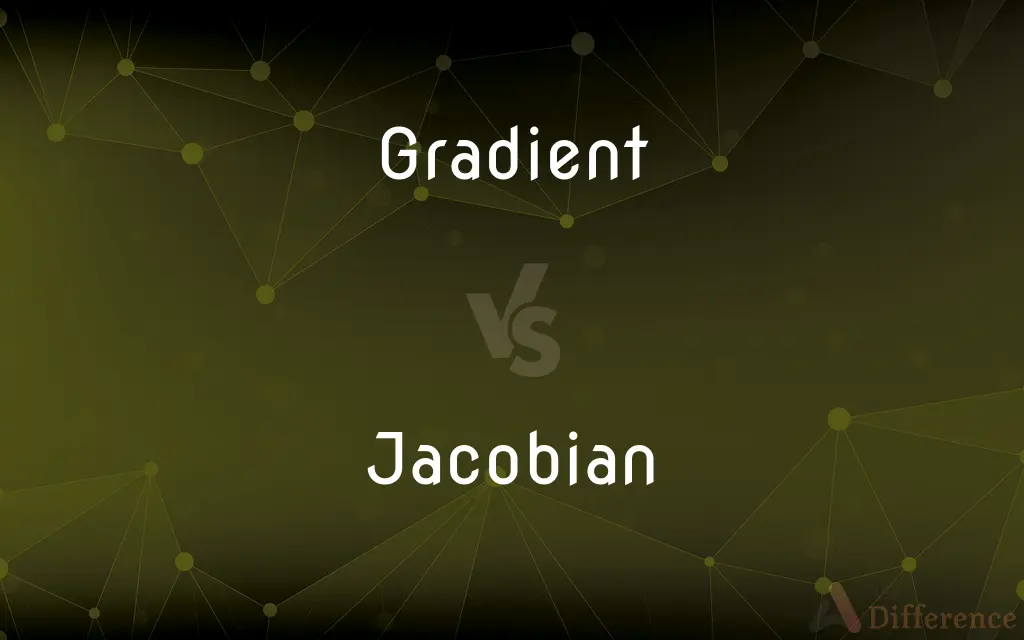Gradient vs. Jacobian — What's the Difference?
By Fiza Rafique & Maham Liaqat — Updated on April 23, 2024
The gradient is a vector representing the direction and rate of fastest increase of a scalar function, whereas the Jacobian is a matrix describing all first-order partial derivatives of a vector-valued function.

Difference Between Gradient and Jacobian
Table of Contents
ADVERTISEMENT
Key Differences
The gradient is applicable to scalar functions of multiple variables, providing the direction and magnitude of the steepest ascent at any point. On the other hand, the Jacobian matrix extends this concept to vector-valued functions, representing the rate of change of each output with respect to each input, effectively generalizing the gradient for functions mapping ℝⁿ to ℝᵐ.
While the gradient results in a vector that points in the direction of the greatest rate of increase of a function, the Jacobian matrix offers a more comprehensive snapshot, detailing how each component of a vector output changes with respect to changes in each component of the vector input. This makes the Jacobian essential in multidimensional function analysis, whereas the gradient is specifically used for optimizing scalar functions.
In terms of physical interpretation, the gradient can be visualized as an arrow pointing uphill on a three-dimensional surface, showing the direction in which the function increases most rapidly. The Jacobian, however, cannot be as easily visualized due to its matrix nature, but it plays a crucial role in transformations and mappings in higher dimensions, particularly in fluid dynamics, robotics, and other fields of engineering and physics.
The computation of the gradient involves taking the partial derivatives of the scalar function with respect to each variable and forming a vector from these derivatives. The Jacobian, while similar in its reliance on partial derivatives, requires constructing a matrix where each row corresponds to the gradient of one of the vector function's components, illustrating the multi-dimensional nature of the function's rate of change.
The practical applications of the gradient and Jacobian often diverge, with the gradient being central to gradient descent algorithms in optimization and machine learning, indicating the direction to move to minimize a function. Meanwhile, the Jacobian is instrumental in solving systems of equations, transforming coordinates, and analyzing the behavior of complex systems, reflecting its broader applicability in mathematical modeling and simulations.
ADVERTISEMENT
Comparison Chart
Definition
Vector of all first-order partial derivatives of a scalar function.
Matrix of all first-order partial derivatives of a vector-valued function.
Result Type
Vector
Matrix
Applicability
Scalar functions of multiple variables
Vector-valued functions mapping ℝⁿ to ℝᵐ
Physical Interpretation
Direction and rate of steepest ascent
Rate of change of each output with respect to each input
Main Use
Optimization, finding maxima and minima
Transformations, system of equations, fluid dynamics
Compare with Definitions
Gradient
Direction of steepest ascent of a scalar function.
The gradient of a hill's height function points towards its peak.
Jacobian
Matrix describing the rate of change of a vector-valued function.
The Jacobian of a transformation maps changes in input directly to output.
Gradient
Vector consisting of partial derivatives.
In two dimensions, the gradient of f(x, y) is [∂f/∂x, ∂f/∂y].
Jacobian
Includes gradients of all output components.
For a function f. ℝ³ → ℝ², the Jacobian is a 2x3 matrix of partial derivatives.
Gradient
Calculated from scalar-valued functions.
The gradient of temperature distribution shows the direction of maximum temperature increase.
Jacobian
Applied in engineering, physics, and robotics.
Jacobian matrices are key in controlling robot arms and modeling fluid flow.
Gradient
Used in optimization and machine learning.
Gradient descent algorithms use the gradient to minimize cost functions.
Jacobian
Represents multi-dimensional rate of change.
In biomechanics, the Jacobian of muscle forces offers insights into motion dynamics.
Gradient
Indicates rate and direction of increase.
A steep gradient implies a rapid increase in the function's value.
Jacobian
Crucial for solving systems and transformations.
The Jacobian determinant assesses volume changes under the function.
Gradient
In vector calculus, the gradient of a scalar-valued differentiable function f of several variables is the vector field (or vector-valued function) ∇ f {\displaystyle \nabla f} whose value at a point p {\displaystyle p} is the vector whose components are the partial derivatives of f {\displaystyle f} at p {\displaystyle p} . That is, for f : R n → R {\displaystyle f\colon \mathbb {R} ^{n}\to \mathbb {R} } , its gradient ∇ f : R n → R n {\displaystyle \nabla f\colon \mathbb {R} ^{n}\to \mathbb {R} ^{n}} is defined at the point p = ( x 1 , … , x n ) {\displaystyle p=(x_{1},\ldots ,x_{n})} in n-dimensional space as the vector: ∇ f ( p ) = [ ∂ f ∂ x 1 ( p ) ⋮ ∂ f ∂ x n ( p ) ] .
Jacobian
Relating to the work of the mathematician K. G. J. Jacobi.
Gradient
A rate of inclination; a slope.
Jacobian
A determinant whose constituents are the derivatives of a number of functions (u, v, w, …) with respect to each of the same number of variables (x, y, z, …).
Gradient
An ascending or descending part; an incline.
Jacobian
Alternative case form of Jacobian
Gradient
(Physics) The rate at which a physical quantity, such as temperature or pressure, changes in response to changes in a given variable, especially distance.
Jacobian
Alternative case form of Jacobian
Gradient
(Mathematics) A vector having coordinate components that are the partial derivatives of a function with respect to its variables.
Gradient
(Biology) A series of progressively increasing or decreasing differences in the growth rate, metabolism, or physiological activity of a cell, organ, or organism.
Gradient
A slope or incline.
Gradient
A rate of inclination or declination of a slope.
Gradient
The ratio of the rates of change of a dependent variable and an independent variable, the slope of a curve's tangent.
Gradient
(science) The rate at which a physical quantity increases or decreases relative to change in a given variable, especially distance.
Gradient
A differential operator that maps each point of a scalar field to a vector pointed in the direction of the greatest rate of change of the scalar. Notation for a scalar field φ: ∇φ
Gradient
A gradual change in color. A color gradient; gradation.
Gradient
Moving by steps; walking.
Gradient
Rising or descending by regular degrees of inclination.
The gradient line of a railroad
Gradient
Adapted for walking, as the feet of certain birds.
Gradient
Moving by steps; walking; as, gradient automata.
Gradient
Rising or descending by regular degrees of inclination; as, the gradient line of a railroad.
Gradient
Adapted for walking, as the feet of certain birds.
Gradient
The rate of regular or graded ascent or descent in a road; grade.
Gradient
A part of a road which slopes upward or downward; a portion of a way not level; a grade.
Gradient
The rate of increase or decrease of a variable magnitude, or the curve which represents it; as, a thermometric gradient.
Gradient
The variation of the concentration of a chemical substance in solution through some linear path; also called concentration gradient; - usually measured in concentration units per unit distance. Concentration gradients are created naturally, e.g. by the diffusion of a substance from a point of high concentration toward regions of lower concentration within a body of liquid; in laboratory techniques they may be made artificially.
Gradient
A graded change in the magnitude of some physical quantity or dimension
Gradient
The property possessed by a line or surface that departs from the horizontal;
A five-degree gradient
Common Curiosities
What is the gradient of a function?
The gradient is a vector indicating the direction and rate of fastest increase of a scalar function.
What is the significance of the Jacobian matrix?
The Jacobian matrix is fundamental for understanding transformations, analyzing fluid dynamics, and solving systems of equations.
What roles does the Jacobian play in engineering?
In engineering, the Jacobian is used in simulations, robot arm control, and understanding how changes in variables affect systems.
How do the gradient and Jacobian differ?
The gradient applies to scalar functions and results in a vector, whereas the Jacobian applies to vector-valued functions and results in a matrix.
Can the gradient be part of the Jacobian?
Yes, for functions mapping ℝⁿ to ℝ, the gradient can be seen as a row (or column) in the Jacobian matrix.
How is the Jacobian matrix calculated?
The Jacobian matrix is calculated by finding the partial derivatives of each component of the vector-valued function with respect to each input variable.
How is the gradient used in machine learning?
In machine learning, the gradient is used in optimization algorithms like gradient descent to minimize error or cost functions.
What is the Jacobian matrix?
The Jacobian matrix is a matrix of all first-order partial derivatives of a vector-valued function, representing how each output changes with each input.
Why is the gradient important?
The gradient is crucial for identifying the direction of steepest ascent in optimization problems and machine learning.
How do you calculate the gradient?
The gradient is calculated by taking the partial derivatives of the function with respect to each of its variables and forming a vector.
What happens if the gradient is zero?
If the gradient is zero, it indicates a local maximum, minimum, or saddle point, where there is no slope or direction of increase.
Is the Jacobian always square?
No, the Jacobian matrix can be rectangular because it depends on the dimensions of the input and output spaces (ℝⁿ to ℝᵐ).
Can the Jacobian determine invertibility?
Yes, a nonzero determinant of the Jacobian matrix at a point suggests that the function is locally invertible at that point.
How does the Jacobian relate to transformations?
The Jacobian matrix relates to transformations by describing how a small change in input variables affects the output, useful for coordinate transformations and scaling.
What information does the gradient convey?
The gradient conveys the direction and magnitude of the function's steepest ascent at a given point.
Share Your Discovery

Previous Comparison
Cur vs. Insolent
Next Comparison
Coal vs. DiamondAuthor Spotlight
Written by
Fiza RafiqueFiza Rafique is a skilled content writer at AskDifference.com, where she meticulously refines and enhances written pieces. Drawing from her vast editorial expertise, Fiza ensures clarity, accuracy, and precision in every article. Passionate about language, she continually seeks to elevate the quality of content for readers worldwide.
Co-written by
Maham Liaqat















































